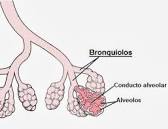The Bronchioles are the small airways into which the bronchi divide, reaching the pulmonary alveoli. The bronchioles are located in the middle part of the lung. In our lungs we have about 60,000 bronchioles that are divided, in turn, into about 600,000. Very small pulmonary ducts formed by the branching of the bronchi . The bronchioles flow into clusters of globular structures called alveoli , where the exchange of oxygen and CO2 gases occurs . Unlike the bronchi, the bronchioles do not have cartilage and their wall is only smooth muscle.

Function
The lungs and their structures are part of the respiratory system, which controls breathing and which also includes the upper respiratory tract passages, the nose , throat and sinuses, the pharynx, and the trachea . The air is aspirated into the lungs through the upper airways until it reaches the alveoli where oxygenates the blood . Deoxygenated blood transfers its carbon dioxide into the alveoli, and carbon dioxide is breathed in through the airways. This process helps transport oxygen in the blood throughout the body, fueling the body’s metabolism.
Anatomy
The bronchial network, like most airways, contains cilia, small finger-shaped cells, on its inner surface to help move air through the system. The bronchioles branch, from the main bronchi, into the terminal bronchioles and the respiratory bronchioles.
Terminal bronchioles
The terminal bronchioles are the most distal segment of the conductive zone. They branch from the smaller bronchioles. Each of the terminal bronchioles divides to form the respiratory bronchioles that contain a small number of alveoli.
Respiratory bronchioles
The respiratory bronchioles are the narrowest airways in the lungs, one-fiftieth of an inch wide.
Associated diseases
Bronchial dysfunction
A bronchial dysfunction can be the cause of life-threatening disorders.
Bronchospasm
The bronchial tubes contract and become narrower, preventing the absorption of oxygen into the blood. It is a symptom of asthma , bronchitis , flu, and respiratory tract infections, as well as anaphylactic shock caused by allergens. Bronchospasms can result as a side effect of certain medications, such as beta-blockers and pilocarpine. They can cause coughing, shortness of breath and hypoxia , lack of oxygen in the body.
Bronchiolitis
It is an inflammation of the bronchioles. It is usually a symptom of viral infection, but in a rare and serious form, called bronchiolitis obliterans, the passageways become blocked by fibrous connective tissue. Most bronchial disorders can be treated by oxygen therapy or bronchodilation, or by treating the underlying cause of the disease. Bronchodilation uses medication or mechanical manipulation to widen the airways in the lungs. Obliterative bronchiolitis, however, is irreversible, and may require lung transplantation in severe cases.
